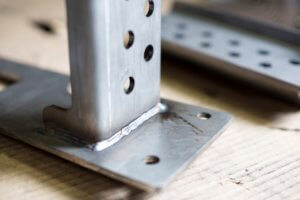Laser Precision Welds Are More Than Good. They’re Certified Good.
November 01, 2017
Almost every job shop has a welder on the payroll, but do you know their background, experience and qualifications? Can you be sure they will do good work? You can be sure if the job is done at Laser Precision because all of our welding is certified by the American Welding Society (AWS) and by Caterpillar’s “7 Steps to Welding Excellence” (7SWE) program.
 How Certification Works
How Certification Works
Being certified by the AWS is not like getting your driver’s license. It’s a continuous process, and it’s very specific. All of our welding is certified to these standards. Testing and audits are conducted on a regular basis against a Welding Procedure Specification (WPS), which is a formal written document describing the parameters of each individual weld (what machine, size and type of wire, voltage range, etc.).
Each type of weld we perform has been tested in an independent lab to make sure they conform to its specified WPS. This ensures that our welding operators are making AWS compliant welds on all of our production jobs. As we add new welds to our portfolio, the certification for that weld is added to our welding capabilities.
In an effort to improve our weld capacity, we go a step further and have our welders undergo a vision test, weld defect test and a test for interpreting welding symbols. We feel certifying our welder’s to these criteria ensures adherence to any and all specifications our customers may require.
 What We Weld
What We Weld
Most of our welding work is a type called metal inert gas (MIG), in which an electric arc forms between a consumable wire electrode and the workpiece metal. This heats the workpiece metal, causing the pieces to melt and join. This gives a high quality, structurally sound fusion of metal.
Typically, we weld metal components that have been bulk cut on our laser machines and then formed. Welding is used to connect the formed pieces together or add other fabricated parts to complete the basic structure of the object.
Our welders are certified for just about any metal-to-metal welding job. Each booth is stocked with both MIG and TIG (tungsten inert gas) units. We also have equipment and certified operators for spot welding and “weld around” work. TIG welding is used for precise control and leaves a more attractive finish. Spot welding melts projections (weld nuts) into the base part for smooth services, and our weld around unit is used for jobs like automatically joining a cylinder to a flat base.
Our Process
A Welding Qualification Matrix in our job router lists all of our welders and the welds they are certified to perform. As each order comes in, the WPS for the job is cross-matched with the matrix so that the project is assigned to one of the welders certified for that particular weld.
If a style of weld is required that is not in our system, a new WPS is created that meets all AWS specifications and an operator is certified for the new weld. The order with the new WPS is subjected to an Advanced Product Quality Planning (APQP) review and print checked against all specifications before the order is assigned to the floor.
The Matrix Difference
Rivets can pop and fasteners can break, but joining two pieces of metal together with welding is strong, fast and permanent – if it’s done right. Certification of all welders, machines and individual welds performed in a shop is not common because it’s expensive and frankly, difficult to achieve. But we think it’s worth the effort to find the right talent and go through continual certification if we can bring value and quality to our customers that they would be hard pressed to find anywhere else.



